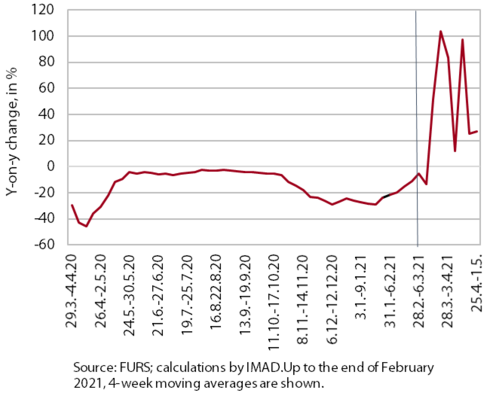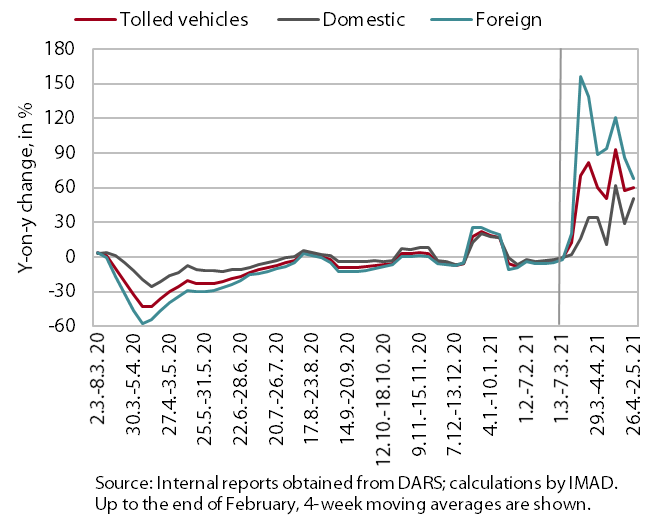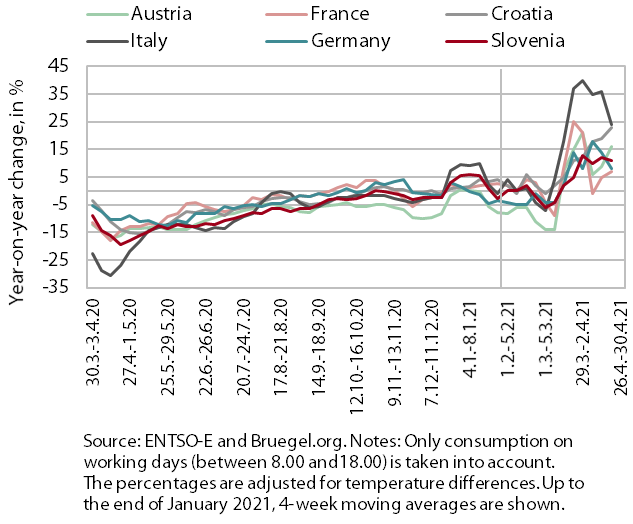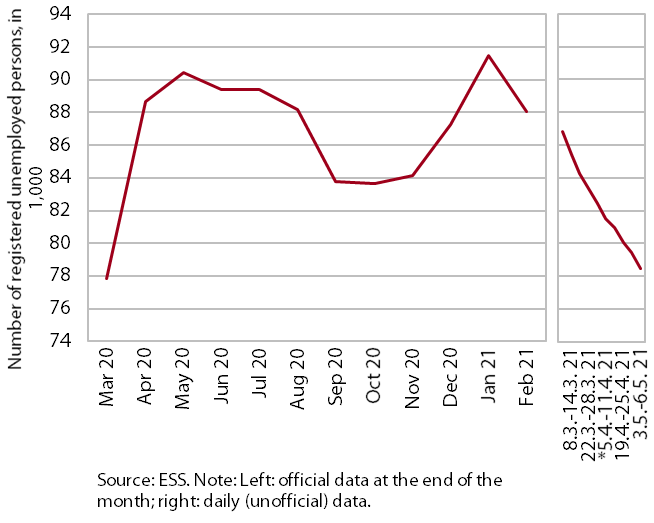Charts of the Week
Current economic trends from 3 to 7 May 2020: fiscal verification of invoices, traffic of electronically tolled vehicles, electricity consumption and registered unemployment
Data on fiscally verified invoices indicate an increase in sales, which in the second half of April, were similar to the same period before the epidemic. Freight traffic on Slovenian motorways and electricity consumption were also higher in the last week of April compared with the same week of the pre-crisis year, to a great extent as a consequence of the distribution of holidays in 2019. All these indicators also point to strong growth year on year, which can be attributed to low activity in April 2020 due to the first wave of the epidemic and the relaxation of measures in the second half of April 2021. At the beginning of May, registered unemployment fell further, but was around 8% higher than at the beginning of May 2019.
Fiscal verification of invoices, April 2021

According to data on fiscally verified invoices, turnover was a quarter higher year on year in the second half of April and similar to that in the same period of 2019. After strong year-on-year growth due to the reopening of the country, growth stabilised at around a quarter higher year-on-year sales in the last two weeks of April. In addition to the low base, the year-on-year growth reflected the further easing of containment measures (the ban on movement between regions was lifted again, a small part of accommodation establishments opened, restaurants and bars were allowed to serve guests outdoors and also indoors in some regions). However, in some segments of services, which in 2020 had already reopened in the last third of April (particularly stores selling furniture, construction materials and motor vehicles), year-on-year growth eased. The total turnover in the second half of April was similar to that in the same period of April 2019, mainly under the impact of strong growth in trade (particularly wholesale trade and the sale of motor vehicles), as turnover in services that were still closed or highly restricted (cultural, entertainment, sports, personal and and food service activities) remained significantly lower than in 2019.
Traffic of electronically tolled vehicles on Slovenian motorways, April 2021

Freight traffic on Slovenian motorways in the last week of April was 60% higher year on year and 29% higher than in the same period of 2019. Between 26 April and 2 May, domestic vehicle traffic was 50% higher and foreign vehicle traffic 68% higher year on year. This strong year-on-year growth was still mainly due to lower traffic in the same period of last year as a consequence of containment measures during the first wave of the epidemic. In the last week of April, traffic volume was almost a fifth lower than in the record previous week, although still significantly higher (by 45% in domestic vehicles and by 21% in foreign vehicles) than in the same week of the pre-crisis year 2019, when traffic volume had been lower due to one fewer working day in the Labour Day holiday week.
Electricity consumption, April 2021

Electricity consumption in the last week of April was 20% higher than in same week of 2020 and 2% higher than in the same week of the pre-crisis year 2019. According to our estimates, the increase relative to the pre-crisis year reflected the easing of measures and the distribution of holidays, while the year-on-year increase was due to the base effect. Particularly due to the base effect, year-on-year higher consumption was also recorded in our main trading partners, from 3% in Austria to 27% in Italy. Compared with the same week of 2019, lower consumption was recorded in Austria (3%), France (4%) and Germany (1%), while consumption in Croatia and Italy was around 4% higher.
Registered unemployment, May 2021

The number of registered unemployed persons fell further at the beginning of May. Following the increases in December and January, which, amid the retention of intervention measures, did not differ much from seasonal increases in the same period of previous years, the number of unemployed continued to fall from February to April. Similar developments were also seen at the beginning of May. On 6 May, 79,994 persons were thus unemployed according to ESS unofficial (daily) data, 1.6% less than at the end of April and around 14% less than in the same period of last year. Compared with the beginning of May 2019, the number was, however, around 8% higher.
